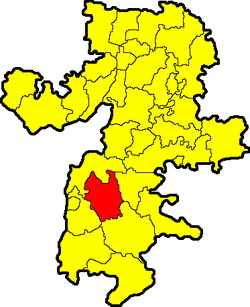Nagaybaksky District
Nagaybaksky District
Нагайбакский район | |
|---|---|
 Location of Nagaybaksky District in Chelyabinsk Oblast | |
| Coordinates: 53°31′N 59°48′E / 53.517°N 59.800°E | |
| Country | Russia |
| Federal subject | Chelyabinsk Oblast[1] |
| Administrative center | Fershampenuaz[1] |
| Area | |
| • Total | 3,022 km2 (1,167 sq mi) |
| Population | |
| • Total | 20,927 |
| • Density | 6.9/km2 (18/sq mi) |
| • Urban | 9.5% |
| • Rural | 90.5% |
| Administrative structure | |
| • Administrative divisions | 1 Work settlements, 9 Selsoviets |
| • Inhabited localities[1] | 1 Urban-type settlements[3], 36 rural localities |
| Municipal structure | |
| • Municipally incorporated as | Nagaybaksky Municipal District[1] |
| • Municipal divisions[1] | 1 urban settlements, 9 rural settlements |
| Time zone | UTC+5 (MSK+2 |
| OKTMO ID | 75642000 |
| Website | http://www.nagaybak.ru/ |
Nagaybaksky District (Template:Lang-ru) is an administrative and municipal district (raion), one of the twenty-seven in Chelyabinsk Oblast, Russia.[1] It is located in the south of the oblast. The area of the district is 3,022 square kilometers (1,167 sq mi).[citation needed] Its administrative center is the rural locality (a selo) of Fershampenuaz.[1] Population: 20,927 (2010 Census);[2] 24,310 (2002 Census);[5] 25,959 (1989 Soviet census).[6] The population of Fershampenuaz accounts for 20.9% of the district's total population.[2]
Symbols
The coat of arms and flag of Nagaybaksky District consists of two wheat stalks holding a sword on a blue field, symbolizing an agrarian population serving for the protection of other agrarians from nomads. The blue field symbolizes their Turkic steppe origin.
References
Notes
- ^ a b c d e f g Resolution #161
- ^ a b c Russian Federal State Statistics Service (2011). Всероссийская перепись населения 2010 года. Том 1 [2010 All-Russian Population Census, vol. 1]. Всероссийская перепись населения 2010 года [2010 All-Russia Population Census] (in Russian). Federal State Statistics Service.
- ^ The count of urban-type settlements may include the work settlements, the resort settlements, the suburban (dacha) settlements, as well as urban-type settlements proper.
- ^ "Об исчислении времени". Официальный интернет-портал правовой информации (in Russian). June 3, 2011. Retrieved January 19, 2019.
- ^ Federal State Statistics Service (May 21, 2004). Численность населения России, субъектов Российской Федерации в составе федеральных округов, районов, городских поселений, сельских населённых пунктов – районных центров и сельских населённых пунктов с населением 3 тысячи и более человек [Population of Russia, Its Federal Districts, Federal Subjects, Districts, Urban Localities, Rural Localities—Administrative Centers, and Rural Localities with Population of Over 3,000] (XLS). Всероссийская перепись населения 2002 года [All-Russia Population Census of 2002] (in Russian).
- ^ Всесоюзная перепись населения 1989 г. Численность наличного населения союзных и автономных республик, автономных областей и округов, краёв, областей, районов, городских поселений и сёл-райцентров [All Union Population Census of 1989: Present Population of Union and Autonomous Republics, Autonomous Oblasts and Okrugs, Krais, Oblasts, Districts, Urban Settlements, and Villages Serving as District Administrative Centers]. Всесоюзная перепись населения 1989 года [All-Union Population Census of 1989] (in Russian). Институт демографии Национального исследовательского университета: Высшая школа экономики [Institute of Demography at the National Research University: Higher School of Economics]. 1989 – via Demoscope Weekly.
Sources
- Законодательное Собрание Челябинской области. Постановление №161 от 25 мая 2006 г. «Об утверждении перечня муниципальных образований (административно-территориальных единиц) Челябинской области и населённых пунктов, входящих в их состав», в ред. Постановления №2255 от 23 октября 2014 г. «О внесении изменений в перечень муниципальных образований (административно-территориальных единиц) Челябинской области и населённых пунктов, входящих в их состав». Вступил в силу со дня официального опубликования. Опубликован: "Южноуральская панорама", №111–112, 14 июня 2006 г. (Legislative Assembly of Chelyabinsk Oblast. Resolution #161 of November 25, 2006 On Adoption of the Registry of the Municipal Formations (Administrative-Territorial Units) of Chelyabinsk Oblast and of the Inhabited Localities They Comprise, as amended by the Resolution #2255 of October 23, 2014 On Amending the Registry of the Municipal Formations (Administrative-Territorial Units) of Chelyabinsk Oblast and of the Inhabited Localities They Comprise. Effective as of the official publication date.).


